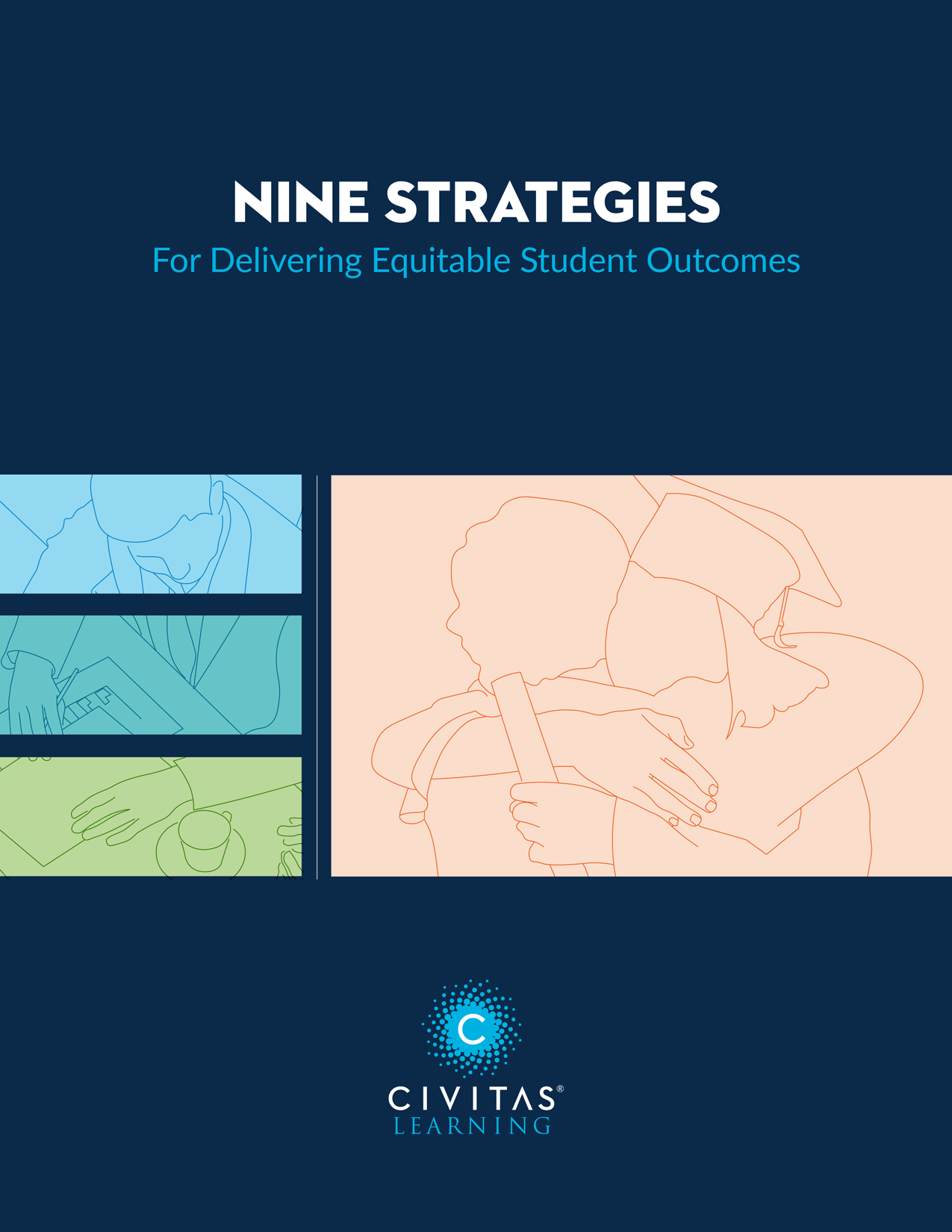Leaders are no strangers to considering equity issues, but the conversation about addressing equity gaps in higher education has broadened beyond the traditional notion of simply promoting access to postsecondary education. Transformational leaders seek to remove barriers to success and ensure that students receive what they need to succeed throughout their college experience.
Predicative analytics and student success software can be important allies in this work. They equip colleges and universities with important information about students’ performance. They also provide the insights and tools needed to identify the underlying “why” and prescribe interventions that address the needs of particular student groups before it’s too late.
Here, we share several of the most effective data-informed student success strategies Civitas Learning partners institutions use to close equity gaps. These approaches include:
- Collect Data and Use Insights to Take Action
- Go Beyond Demographics and Historical Academic Data
- Understand the Impact of Student Success Services and Programs
- Use Automated Alerts and Messages with Caution
- Accommodate Student Needs with Holistic Planning and Scheduling
- Enable Academic Advisors to Do Their Highest and Best Work
But before we dive into how our partners use student success analytics to close equity gaps in student success, let’s take a moment to explore why analytics and technology are an essential part of this work.
Closing Equity Gaps with Student Success Software
Equity, as Achieving the Dream defines it, is “ensuring that each student receives what he or she needs to be successful through the intentional design of the college experience” —though the organization recommends that each institution define what equity means on its campus.
As higher education continues to become more resource-constrained, it may feel impossible to provide adequate services to ensure each student receives what they need to be successful. But scaling student success doesn’t necessarily mean increasing staff or expanding initiatives.
Student success software can give your teams the real-time visibility they need to identify student needs, develop effective strategies, and take coordinated action to achieve more equitable outcomes. Existing processes can unintentionally reinforce barriers if institutions don’t have insight into what interventions work for specific student groups. When you know what’s working for your students, the path to remove hidden barriers and unintended consequences that limit equitable student success becomes much clearer.
Student success software, like the Civitas Learning Student Impact Platform, enables institutions to identify how to address specific equity gaps. Faculty and staff can clearly understand barriers and prescribe the right interventions. Administrators become equipped with real-time data to fine-tune initiatives, policies, and investments to influence the success of students and institutions.
What Matters Most For Equity.
6 Ways to Use Student Success Software to Close Equity Gaps in Higher Education
Data and predictive analytics can help you identify which students are most likely to succeed on your campus. But more importantly, they should provide insights that you can act on to change students’ outcomes meaningfully.
Here are some of the most effective evidence-based approaches Civitas Learning partner institutions use to close equity gaps and improve outcomes:
1. Collect Data and Use Insights to Take Action
Continuously collecting and monitoring data allows institutions to diagnose student needs and prescribe interventions that work for particular students or student groups. This approach provides a clearer, quicker path toward student equity. The willingness to go beyond assumptions and respond accordingly can be the difference between spending years researching the issue of equity or moving ahead now with initiatives that facilitate more equitable outcomes.
Unfortunately, collecting data to examine the impact of services, programming, and interventions on equity has been minimal. Traditional measures of student support programs have focused primarily on student satisfaction, participation levels, and general results. While useful, these measures do not control for selection bias or provide sufficient specificity about impacts on particular students or sub-populations.
Instead of making assumptions about what works and for whom, student success software provides the infrastructure needed to collect and synthesize the breadth and depth of data needed to understand your students’ needs.
In some cases, while an intervention positively impacts overall persistence, some student subpopulations experience a negative or neutral impact—and vice versa. General trends can provide community benchmarks and broader signals, but an institution’s specific data and analytics should inform student success professionals’ actions to improve student outcomes.
How Actionable Analytics Move the Needle On Student Success
2. Go Beyond Demographic and Historical Student Data
Look beyond just demographic breakdowns for the greatest benefit to your students and institution. Instead, consider who has the highest level of predicted vulnerability or risk among all groups of students right now.
Historically prioritized students might not always be the ones who need support most. Instead of designing outreach according to student status – first-generation, financial aid received, or demographic information, for example – also look at predictors of success within each subpopulation to determine what students need.
Demographics are not something people can change. Incorporating engagement and behavior data provides actionable context to help guide students toward better outcomes. Incorporating this information is critical for a more timely and equitable approach to understanding your students. Additionally, more robust, real-time views of student vulnerability or risk help avoid reductionist thinking or generalizations about who needs support.
How Institution-Specific Analytics Improve Student Outcomes
3. Understand the Impact of Student Success Services and Programs
Understanding the impact of student success initiatives for historically underserved students is an important consideration in your work to create more inclusive student experiences and learning journeys.
Higher education leaders and their teams must know who needs support and when. What works and for whom? Which combinations of strategies best accomplish the goal of promoting equity in student success?
By examining institution-specific data in various ways, schools can get a complete picture of the combination of support services to employ. An institution can analyze initiatives and policies, starting with the most used, to understand the impact on different types of students. Advisors and support staff can use this information to connect students with the most effective resources. Administrators and institutional research (IR) teams can consider this information when making investment decisions or evaluating adjustments to policies and practices.
Additionally, evaluating program effectiveness using a more comprehensive indicator of risk that includes more student attributes and behavioral data to segment the analytics reveals that students with the highest predicted risk stand to benefit most from student success plans.
This is great news because connecting these students with those resources can directly impact their success and improve the ROI of the program investment.
Unlock Enrollment Strategies by Segmenting Student Data
4. Use Automated Alerts and Messages with Caution
For students who are predicted to be most vulnerable or at risk, highlighting their academic struggle may do more harm than good. Regardless of the system or process you use to identify struggle, highlighting a student’s risk through an automated flag or transactional message sent directly to the student magnifies their vulnerability.
Automated alerts and flags, intended to scale student outreach and provide early notifications for at-risk students, had the highest percentage of negative or insignificant impact on students among the program categories we analyzed in examining what matters most for equity.
If your institution uses early alerts, it’s important to be intentional about how advisors and student support teams communicate these risks to students. When your student support staff contacts students, avoid formal or transactional messaging. Instead, craft communication to include personalization and growth-mindset-based messaging that lets your students know how much you care about them.
As part of student success software, the ability to segment your student success analytics enables student support teams to scale personalized outreach and effectively coordinate student support efforts that improve equitable outcomes.
If the goal is to keep students on their academic journey, it is vital to prioritize inclusivity when connecting with and supporting students. It’s critical to equip advising and student support with an ability to proactively engage students and tools to create a support network that improves outcomes.
5. Accommodate Student Needs with Student-Centered Scheduling
First-time students and returning students alike often struggle to navigate the process of course registration. They feel unclear about what courses they need to take or cannot create a course schedule that accommodates other obligations. This uncertainty can result in late registration, which compounds students’ ability to persist or even complete their degree program on time.
When student planning and registration tools are coupled with student success analytics, advisors can help students build plans and schedules that support their priorities, preferences, and goals. Advisors can reduce uncertainty about where to start when they preload schedule recommendations for students before their registration process.
Institutions that help students balance their learning with their lives enhance a student’s ability to succeed despite their circumstances. Otherwise, institutions risk perpetuating barriers based on students’ ability to prioritize learning.
Student scheduling software can help institutions understand long and short-term course demands to ensure students can access the necessary courses. Enrollment teams can use data collected about student schedule preferences and breaks to offer class sections that help students balance school and life.
4 Ways to Remove Barriers to Course Registration
6. Enable Academic Advisors to Do Their Highest & Best Work
Our analysis of what works for equity suggests that holistic academic advising practices consistently improve outcomes for historically underserved and vulnerable populations. This doesn’t mean institutions must hire more advisors or ask advisors to do more. Most institutions cannot afford to hire more advisors; those that effectively scale holistic academic advising make sure their advisors can do their best work effectively and efficiently.
To make the biggest daily impact, teams should look at specific success predictions to prioritize advisor-student engagement instead of assuming a certain student population needs support. This approach enables advising and enrollment teams to focus their limited time on the students who need their support immediately. The students who need advising support are also less likely to seek it out. Using data to get a more comprehensive view of what students need and prioritize where to engage early means advisors can proactively support students and focus time where they will have the biggest impact.
A New Approach to Academic Advising Caseload Management
More Equitable Outcomes for Students Are Within Reach
These findings mean that an advisor’s relationships with students matters, personalized outreach matters, and proactive attention to student needs matters. There is also a tremendous opportunity to leverage deeper intelligence to guide work to address equity gaps, challenge unconscious bias, and dismantle barriers that are limiting student success.
More equitable outcomes for the students we serve are within our reach. We understand that it’s not always obvious to know where or how to start the critical work to address disparities, but together, we can. Even best practices won’t guarantee improved outcomes. Knowing what works for your students does. When we look closer, it’s clear that improving visibility across campus and prioritizing the student experience makes all the difference.









